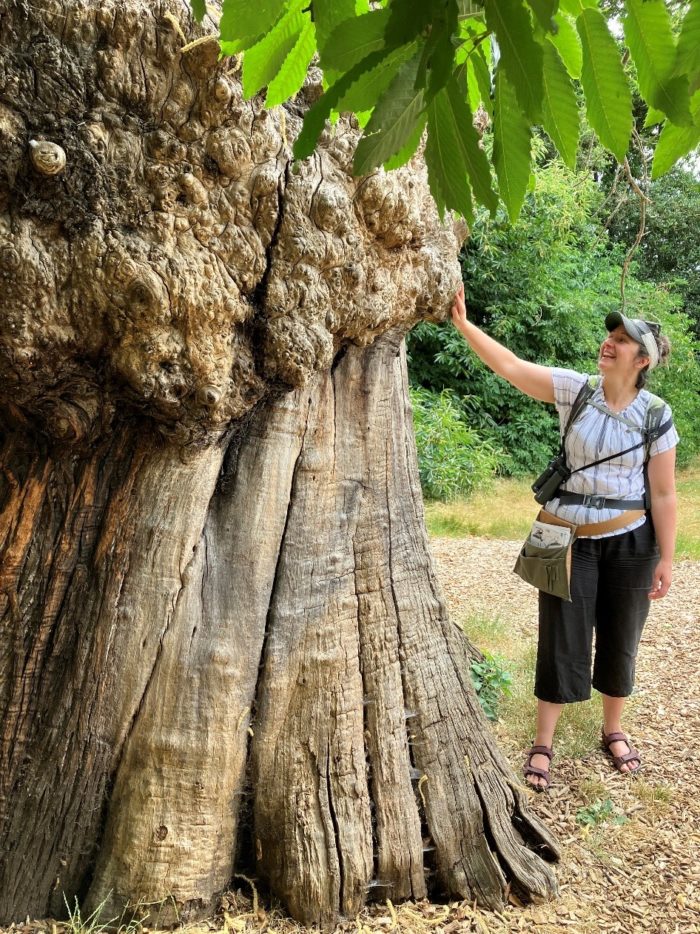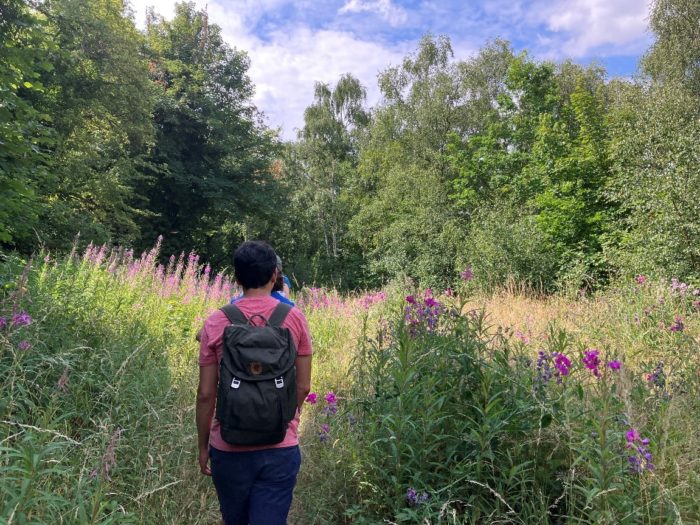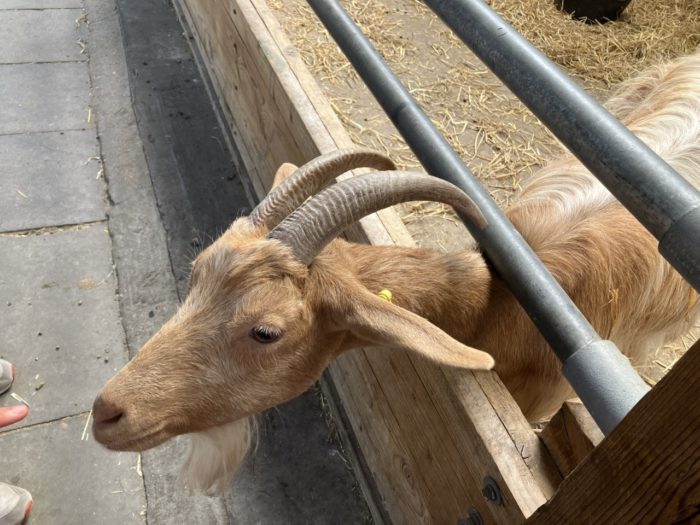Reflecting on Adventures in Multispecies Ethnography
Serena Turton-Hughes, October 2022
Designed and facilitated by Maisie Tomlinson, Adventures in Multispecies Ethnography was an immersive three-day workshop in London, July 2022. It was intended to introduce us to multispecies ethnography (MSE), MSE methods, and give us practical experience in applying some of the methods discussed. Mornings at Goldsmiths University of London usually focused on the theory behind each method we covered: collaboration with experts; sensory ethnography; and qualitative behavioural analysis (QBA). In the afternoons we explored the morning’s methods in the real world through visits to Greenwich Park, New Cross Gate Cutting (part of the Great North Wood, London) and Mudchute City Farm. Activities ranged from traditional lectures, group analysis of animal behaviour via video clips, through to guiding a blindfolded partner through a sensory banquet for their finger.
Across the three days, we networked and bonded as a group of researchers with disparate yet also converging interests. One of the outputs of the workshop was a Discord group where we now connect: sharing readings, photographs, notes and discussions with one another as we each move forwards with our research. It felt refreshing to spend three full days focused on MSE, a term I had come across in my readings, but not fully delved into. The workshop helped me to gain clarity on MSE and gave me a flavour of multisensory MSE methods. It left me pondering the subjectivity of more-than-human forest-dwellers in my research and how MSE might be applied to extinction monitoring.
What is multispecies ethnography?
Multispecies ethnography is an approach from anthropology (Kirksey & Helmreich, 2010) that interacts considerately and purposefully with more-than-humans as lively subjects with their own agency. MSE methods pay careful attention to the viewpoints of more-than-humans, their entanglements with social and cultural worlds, and the influences and power that these connections can exert. Examples of MSE span matsutake mushrooms (Tsing, 2015), forests (Kohn, 2013), and bees (Kosek, 2010), through to contact zones with laboratory mice (Tomlinson, 2019). Maisie explained that she divides MSE into two types: MSE type 1, recognising and working with the agency of more-than-humans; and MSE type 2, which treats more-than-humans as intersubjective, individual actors who experience pain and emotions, with the latter category being restricted to sentient beings.
A flavour of MSE methods:
We experienced expert collaboration through Brenna, a natural historian from Wild Capital. She shared rich knowledge of more-than-humans in Greenwich Park. This included species identification of plants and animals (“there goes a Speckled wood butterfly!”), but also histories of particular trees in their context, how burrs from neighbouring trees had been used in car dashboards, and insights into the mating rituals of pigeons. It was fascinating and made the multispecies feeding frenzy at the pond (when a local resident brought bread) feel all the more vibrant in its drama and liveliness. Thanks to Brenna’s expertise, I was able to produce a diagrammatic web of entanglements much deeper and broader by the end of the day for my chosen subject, a Sweet chestnut (Castanea sativa) tree. I did, however, notice myself falling towards the lure of expertise: feeling the need to scientifically identify every species, where this was not previously necessary. I tried to learn and repeat identifications, both to emulate the expert and be a ‘good student’. Noticing this reminded me that I should take care in bolstering other types of knowing, as well as those which seem impressive to the outsider: other types of knowing also hold validity and add to the conversation.

Brenna, a natural historian from the organisation “Wild Capital” touches the burr of a sweet chestnut tree, whilst she shares her expertise.
The following day, MSE methods and multisensory ethnography provided a refreshing way to test-out what moving beyond the visual means and what it feels like to experience this. In New Cross Gate Cutting, we spent time exploring the meadow and woodland with heightened attention to chosen senses: closing our eyes to listen to the sounds in the environment, exploring bark and ivy with fingertips, and, where eyes were open, focussing attention on all details of a single organism. For me, this was a reminder to explore beyond the visual in my research and recognise the abundance of multisensory experiences available in a forest: not only making the invisible visible in reinvigorated ways, but also the unheard heard, or the unsmelled smelled.

The group walking through a meadow towards woodland in the Great North Wood, London.

A goat stretches through fencing towards an outstretched hand at Mudchute Farm.
For my final reflections on MSE, I pondered where MSE will be used in extinction studies in the future. Perhaps in the contested (dis)counting of species for the IUCN Red List (Celermajer and Wallach, 2021), using MSE to explore how the more-than-human influence and interact with being (dis)counted. Perhaps in continuing to understand the entanglements between at-risk species, greater cases can be made for conservation. I concluded that MSE offers methodological approaches that can draw attention to neglected species and their entanglements from multispecies perspectives, providing practical research methods for multispecies justice. This makes MSE a powerful tool in the way we research extinction, stories shared from that research, and whose stories they are.
References:
Celermajer, D., & Wallach, A. D. (2021). Counting and Discounting Life in an Age of Extinction. Theorizing the Contemporary, Fieldsights. https://culanth.org/fieldsights/counting-and-discounting-life-in-an-age-of-extinction
Kirksey, S. E., & Helmreich, S. (2010). The Emergence of Multispecies Ethnography. Cultural Anthropology, 25(4), 545–576. https://doi.org/10.1111/j.1548-1360.2010.01069.x
Kohn, E. (2013). How Forests Think: Toward an Anthropology Beyond the Human. Univ of California Press.
Kosek, J. (2010). Ecologies of Empire: On the New Uses of the Honeybee. Cultural Anthropology, 25(4), 650–678. https://doi.org/10.1111/j.1548-1360.2010.01073.x
Tomlinson, M. (2019). Measuring ephemera: Finding the “qualitative” in Qualitative Behaviour Assessment as a “whole-animal” science of animal welfare. HoST - Journal of History of Science and Technology, 13(2), 60–85. https://doi.org/10.2478/host-2019-0013
